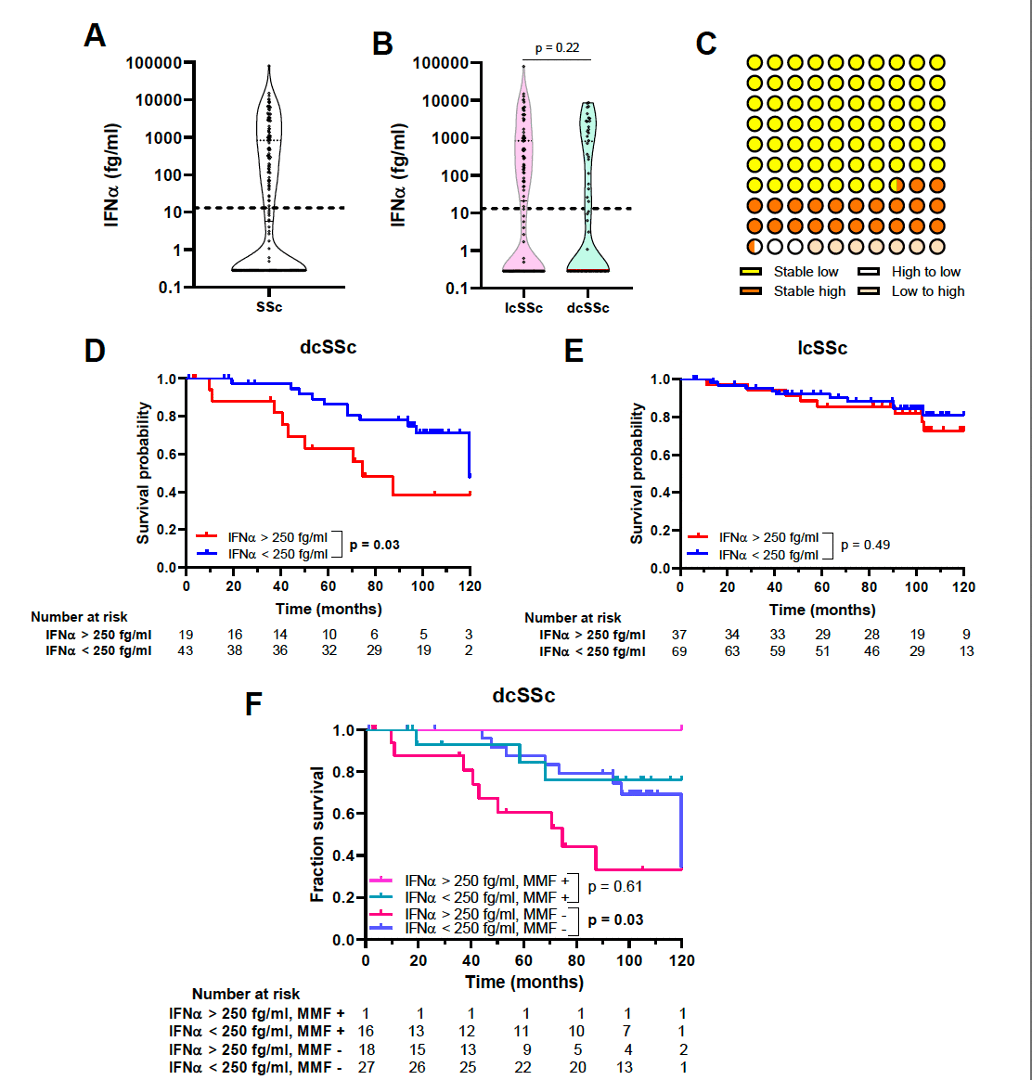Session Information
Session Type: Poster Session C
Session Time: 10:30AM-12:30PM
Background/Purpose: Systemic sclerosis (SSc) is a connective tissue disease characterized by skin and organ fibrosis, autoimmunity, and vasculopathy. Although its pathophysiology remains unclear, recent data implicate the type I interferon pathway in the mechanisms of fibrosis, and interferon signalling is currently targeted in clinical trials. Genome-wide association studies have identified polymorphisms in interferon pathway genes as risk factors for SSc and a type I IFN signature is found in PBMC, skin and lung of SSc patients but studies about plasmatic interferon alpha dosages are lacking.
Methods: We performed a monocentric longitudinal study about plasmatic interferon alpha (IFNα) levels in SSc. IFNα levels were assessed in patients SSc patients from the French National Reference Centre for Systemic Sclerosis and correlated with patient characteristics and outcomes. Patients were included in the study if they fulfilled 2013 ACR/EULAR classification criteria for SSc. Using a single-molecule array (SiMoA) technique that detects all 12 subtypes of IFNα, we retrospectively assessed plasmatic IFNα levels in frozen plasma samples from. Baseline plasmatic IFNα levels above 13.3 fg/ml were considered increased.
Results: Sixty-four diffuse cutaneous SSc (dcSSc) and 109 limited cutaneous SSc (lcSSc) were included in the study. Of these, IFNα levels were assessed longitudinally in 126 patients. Baseline IFNα level was characterized by significant heterogeneity (Fig. 1A). Eighty-one (47%) patients had increased baseline plasmatic IFNα levels. Baseline IFNα was not associated with SSc type, skin fibrosis, organ involvement, or autoantibodies (Fig. 1B) but was statistically significantly lower in patients receiving mycophenolate mofetil (MMF) than in MMF-naive patients (median 0.28 [0.28-0.28] vs 13.78 [0.28-973.5] fg/mL, p 0.001). In the longitudinal cohort, IFNα levels remained stable over time in 91% of the patients (Fig. 1C). Using a sensitivity analysis, a cut-off value of 250 fg/mL was used to analyze disease mortality, distinguishing 57 (33%) and 116 (67 %) patients with high-IFNα and low-IFNα levels, respectively. These groups were similar except for muscle involvement, which was more common in high-IFNα patients (39% vs 22%, p 0.03), and MMF usage, which was more common in the low-IFNα subgroup (16% vs 2%, p < 0.01). Overall survival (OS) was lower in the high-IFNα than in the low-IFNα subgroup in dcSSc patients (p = 0.03), but not in lcSSc patients (p 0.49 Fig. 1D-E). This effect was mainly driven by the decreased OS of MMF-naïve patients with high-IFNα compared to the other patients (Fig. 1F).
Conclusion: This study shows that IFNα dosage could be used to select patients for treatment with anti-IFNAR mAbs, as therapeutic drug monitoring to monitor treatment response, and that combination therapy with a conventional immunosuppressant, namely MMF, and an IFNα-targeted treatment could be beneficial in SSc.
To cite this abstract in AMA style:
Maillet F, Schmidt C, Bondet V, Bense A, Duffy D, Mouthon L, Rodero M, Chaigne B. High Levels of Circulating IFNα Are Associated with Increased Mortality in Patients with Diffuse Cutaneous Systemic Sclerosis [abstract]. Arthritis Rheumatol. 2024; 76 (suppl 9). https://acrabstracts.org/abstract/high-levels-of-circulating-ifn%ce%b1-are-associated-with-increased-mortality-in-patients-with-diffuse-cutaneous-systemic-sclerosis/. Accessed .« Back to ACR Convergence 2024
ACR Meeting Abstracts - https://acrabstracts.org/abstract/high-levels-of-circulating-ifn%ce%b1-are-associated-with-increased-mortality-in-patients-with-diffuse-cutaneous-systemic-sclerosis/

